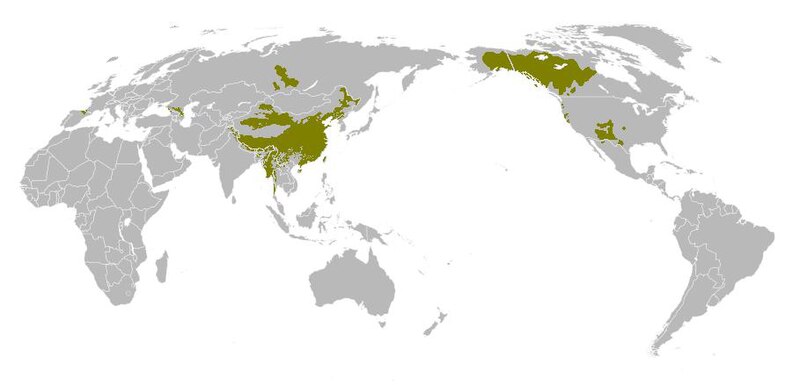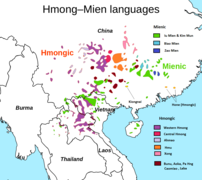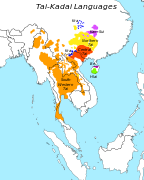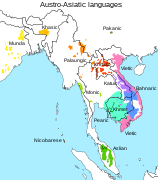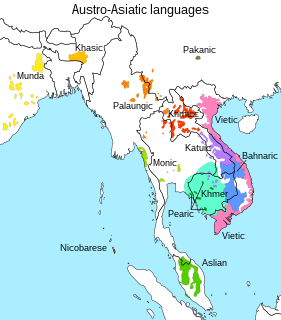
The Austroasiatic languages, also known as Mon–Khmer, are a large language family of Mainland Southeast Asia, also scattered throughout parts of India, Bangladesh, Nepal, and southern China. There are around 117 million speakers of Austroasiatic languages. Of these languages, only Vietnamese, Khmer and Mon have a long-established recorded history and only Vietnamese and Khmer have official status as modern national languages. The Mon language is a recognised indigenous language in Myanmar and Thailand. In Myanmar, the Wa language is the de facto official language of Wa State. Santali is one of the 22 scheduled languages of India. The rest of the languages are spoken by minority groups and have no official status.

Sino-Tibetan, in a few sources also known as Trans-Himalayan, is a family of more than 400 languages, second only to Indo-European in number of native speakers. The vast majority of these are the 1.3 billion native speakers of Chinese languages. Other Sino-Tibetan languages with large numbers of speakers include Burmese and the Tibetic languages. Other languages of the family are spoken in the Himalayas, the Southeast Asian Massif, and the eastern edge of the Tibetan Plateau. Most of these have small speech communities in remote mountain areas, and as such are poorly documented.
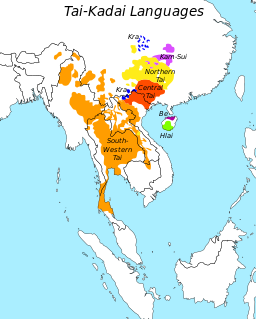
The Kra–Dai languages are a language family of tonal languages found in Mainland Southeast Asia, southern China, and Northeast India. They include Thai and Lao, the national languages of Thailand and Laos respectively. Around 93 million people speak Kra–Dai languages, 60% of whom speak Thai. Ethnologue lists 95 languages in the family, with 62 of these being in the Tai branch.

A wide variety of languages are spoken throughout Asia, comprising different language families and some unrelated isolates. The major language families include Altaic, Austroasiatic, Austronesian, Caucasian, Dravidian, Indo-European, Afroasiatic, Siberian, Sino-Tibetan and Kra–Dai. Most, but not all, have a long history as a written language.
The languages of East Asia belong to several distinct language families, with many common features attributed to interaction. In the Mainland Southeast Asia linguistic area, Chinese varieties and languages of southeast Asia share many areal features, tending to be analytic languages with similar syllable and tone structure. In the 1st millennium AD, Chinese culture came to dominate East Asia. Classical Chinese was adopted by scholars in Vietnam, Korea, and Japan. There was a massive influx of Chinese vocabulary into these and other neighboring languages. The Chinese script was also adapted to write Vietnamese, Korean, and Japanese, though in the first two the use of Chinese characters is now restricted to university learning, linguistic or historical study, artistic or decorative works and newspapers.
In historical linguistics, an Urheimat is the area of origin of the speakers of a proto-language, the parent language of a group of languages assumed to be genetically related.

The Nung are a Central Tai ethnic group living primarily in northeastern Vietnam and southwestern Guangxi. The Nung sometimes call themselves as Tho, which literally means autochthonous. Their ethnonym is often mingled with that of the Tày as Tày-Nùng.

The Hmong–Mien languages are a highly tonal language family of southern China and northern Southeast Asia. They are spoken in mountainous areas of southern China, including Guizhou, Hunan, Yunnan, Sichuan, Guangxi, and Hubei provinces; the speakers of these languages are predominantly "hill people" in contrast to the neighboring Han Chinese who have settled the more fertile river valleys.

The Austric languages are a proposed language family that includes the Austronesian languages spoken in Taiwan, Maritime Southeast Asia, the Pacific Islands, and Madagascar, as well as the Austroasiatic languages spoken in Mainland Southeast Asia and South Asia. A genetic relationship between these language families is seen as plausible by some scholars, but remains unproven.

Borean is a hypothetical linguistic macrofamily that encompasses almost all language families worldwide except those native to sub-Saharan Africa, New Guinea, Australia, and the Andaman Islands. Its supporters propose that the various languages spoken in Eurasia and adjacent regions have a genealogical relationship, and ultimately descend from languages spoken during the Upper Paleolithic in the millennia following the Last Glacial Maximum. The name Borean is based on the Greek βορέας, and means "northern". This reflects the fact that the group is held to include most language families native to the northern hemisphere. Two distinct models of Borean exist: that of Harold C. Fleming and that of Sergei Starostin.
The classification of the Japonic languages and their external relations is unclear. Linguists traditionally consider the Japonic languages to belong to an independent family; indeed, until the classification of Ryukyuan as separate languages within a Japonic family rather than as dialects of Japanese, Japanese was considered a language isolate.
The Kam–Tai languages, also called Dong–Tai or Zhuang–Dong in China, are a proposed primary branch of the Kra–Dai language family. The Kam–Tai grouping is primarily used in China, including by the linguists Liang & Zhang (1996).

The peopling of Thailand refers to the process by which the ethnic groups that comprise the population of present-day Thailand came to inhabit the region.
The Austro-Tai languages, sometimes also Austro-Thai languages, are a proposed language family that includes the Austronesian languages spoken in Taiwan, Maritime Southeast Asia, the Pacific Islands, and Madagascar, as well as the Kra–Dai languages spoken in Mainland Southeast Asia.
Sino-Austronesian or Sino-Tibetan-Austronesian is a proposed language family suggested by Laurent Sagart in 1990. Using reconstructions of Old Chinese, Sagart argued that the Austronesian languages are related to the Sinitic languages phonologically, lexically and morphologically. Sagart later accepted the Sino-Tibetan languages as a valid group and extended his proposal to include the rest of Sino-Tibetan. He also placed the Tai–Kadai languages within the Austronesian family as a sister branch of Malayo-Polynesian. The proposal is controversial, but still being debated.
Proto-Hmong–Mien is the reconstructed ancestor of the Hmong–Mien languages.

The Mainland Southeast Asia linguistic area is a sprachbund including languages of the Sino-Tibetan, Hmong–Mien, Kra–Dai, Austronesian and Austroasiatic families spoken in an area stretching from Thailand to China. Neighbouring languages across these families, though presumed unrelated, often have similar typological features, which are believed to have spread by diffusion. James Matisoff referred to this area as the Sinosphere, contrasted with the "Indosphere", but viewed it as a zone of mutual influence in the ancient period.
Cahiers de Linguistique Asie Orientale is a peer-reviewed academic journal of East Asian linguistics that was established in 1978 and is published by Brill. The articles published before 2007 are in free access on the Persée website.
The East Asian languages are a language family proposed by Stanley Starosta in 2001. The proposal has since been adopted by George van Driem.
